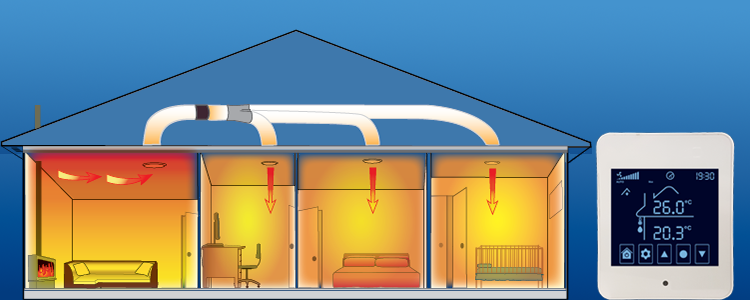How DVS Heat Transfer Systems Are Driving Sustainability Trends in Thermal Engineering
Wiki Article
A Comprehensive Overview to Choosing the Right Heat Transfer Systems for Your Needs
Choosing the appropriate Heat transfer system is necessary for operational efficiency. Numerous systems deal with various requirements, influenced by aspects such as temperature level variety and liquid kind. Understanding the concepts behind Heat transfer, such as transmission, convection, and radiation, is essential. In addition, examining power sources and maintenance techniques can influence long-term performance. A closer assessment of these factors to consider reveals just how to customize a system to details needs. What should one prioritize in this complicated decision-making process?Understanding Heat Transfer: Key Concepts and Concepts
Heat transfer might appear like an uncomplicated principle, it incorporates a range of principles that are essential for effective system layout - DVS Heat Transfer Systems. Recognizing these concepts is crucial for designers and developers who intend to maximize thermal performance in various applications. Transmission, for circumstances, entails the transfer of Heat through strong materials, while convection refers to the activity of Heat within liquids. Radiation, another crucial concept, describes exactly how Heat can be transferred through electromagnetic waves. Each of these systems plays a vital role in determining just how power relocates within a system. By extensively grasping these principles, specialists can make educated decisions, ensuring that Heat transfer systems run successfully and satisfy the specific needs of their applications
Kinds of Heat Transfer Solutions: An Overview
Comprehending the principles of Heat transfer lays the foundation for checking out the different sorts of Heat transfer systems readily available. Heat transfer systems can be classified mostly into three kinds: convection, transmission, and radiation. Conduction entails Heat transfer with solid products, counting on straight get in touch with between fragments. Convection, on the other hand, occurs in liquids (gases and liquids) where the motion of the liquid itself facilitates Heat transfer. Radiation entails the transfer of Heat with electro-magnetic waves and does not require a tool, enabling it to occur in a vacuum. Each type of system has distinctive qualities and applications, making it crucial for individuals and companies to carefully analyze their particular demands when choosing one of the most suitable Heat transfer option.Applications of Heat Transfer Systems in Different Industries
Heat transfer systems play a crucial function across various markets, impacting performance and item quality. In industrial manufacturing procedures, they assist in exact temperature level control, while in food and beverage processing, they ensure safety and conservation. Furthermore, a/c and environment control systems count heavily on effective Heat transfer to preserve comfy environments.Industrial Manufacturing Processes

Numerous industrial production processes rely heavily on reliable Heat transfer systems to optimize efficiency and enhance item high quality. In fields such as metalworking, Heat exchangers play an important role in maintaining suitable temperatures throughout welding, spreading, and creating. These systems ensure uniform Heat circulation, which is essential for accomplishing wanted material properties. Likewise, in the chemical manufacturing sector, Heat transfer systems facilitate precise temperature control throughout responses, influencing yield and safety and security. Additionally, in fabric manufacturing, efficient Heat administration is essential for coloring and completing procedures, influencing color consistency and fabric high quality. By choosing proper Heat transfer innovations, producers can boost power performance and reduce operational costs, inevitably leading to an extra competitive and sustainable production setting.
Food and Drink Processing
Effective Heat transfer systems are just as essential in the food and beverage processing market, where maintaining ideal temperature levels is crucial for food safety and security and quality. These systems play a crucial function in processes such as pasteurization, sterilization, and food preparation, making sure that items are safe for intake and keep their dietary worth. Heat exchangers, for example, successfully transfer Heat in between fluids, enhancing energy usage while minimizing temperature level fluctuations. Furthermore, refrigeration systems are basic for extending and maintaining perishable products service life. The choice of Heat transfer modern technology directly affects functional efficiency and product honesty, making it vital for food and beverage producers to pick the appropriate systems tailored to their particular handling requirements. This mindful selection eventually adds to consumer satisfaction and food security.
A/c and Climate Control
While several markets rely on Heat transfer systems for performance, A/C (Home Heating, Ventilation, and Cooling) plays an important role in maintaining indoor environment control across numerous settings. These systems use Heat transfer concepts to regulate temperature, humidity, and air quality, guaranteeing comfort and security in residential, industrial, and commercial settings. Appropriately designed a/c systems enhance power efficiency, minimize operational expenses, and decrease environmental impact. In commercial buildings, for circumstances, reliable environment control contributes to worker efficiency and customer complete satisfaction. In commercial applications, HVAC systems help maintain excellent conditions for equipment operation and product conservation. Picking the right Heat transfer system is important for meeting certain environment control needs and achieving general system efficiency.Evaluating Power Sources for Heat Transfer Solutions
In evaluating energy sources for Heat transfer systems, a comparison of renewable energy choices and fossil gas considerations is crucial. Renewable resources, such as solar and wind, deal lasting choices that can lower ecological effect. On the other hand, nonrenewable fuel sources continue to be prevalent due to their well-known facilities and power density, triggering a careful assessment of both options.Renewable Resource Options

Nonrenewable Fuel Source Factors To Consider
Examining fossil fuel factors to consider is vital for the performance and sustainability of Heat transfer systems. Fossil fuels, such as gas, oil, and coal, are traditional energy resources that give substantial Heat output, making them preferred choices for household and industrial applications. Nonetheless, their environmental influence, including greenhouse gas emissions and resource deficiency, raises problems. When picking a warm transfer system, it is important to analyze the accessibility, price, and regulatory aspects connected with these fuels. Additionally, the performance of nonrenewable fuel source systems must be considered, as higher efficiency can alleviate some ecological drawbacks. Ultimately, a balanced strategy weighing performance and sustainability can assist decision-makers towards the most appropriate Heat transfer remedy for their specific requirements.Elements to Take Into Consideration When Selecting a Heat Transfer System
Selecting an appropriate Heat transfer system needs cautious factor to consider of numerous aspects that can significantly impact efficiency and efficiency. One crucial variable is the operating temperature level range, which determines the materials and style ideal for the application. Additionally, the kind of liquid used in the system-- whether gas or fluid-- influences Heat transfer performance and compatibility. The system's dimension and ability must line up with the particular needs of the procedure to avoid ineffectiveness. Energy resource schedule is likewise crucial, affecting operating costs and sustainability. The setup environment, including room restrictions and availability for maintenance, plays a considerable duty in system option. Regulatory conformity and security standards need to be thought about to ensure the system fulfills all lawful needs.Upkeep and Effectiveness Optimization for Heat Transfer Equipments
Maintaining Heat transfer systems is vital for ensuring maximum performance and longevity. Regular upkeep tasks, such as cleansing Heat exchangers and inspecting insulation, help protect against effectiveness losses as a result of fouling and thermal connecting. In addition, keeping an eye on system parameters, consisting of stress and temperature, enables early discovery of anomalies, lessening downtime and expensive repair services. Executing a preventative maintenance timetable can enhance efficiency and extend the life-span of parts. Upgrading to sophisticated control systems can enhance operational efficiency by readjusting to varying lots and conditions. By focusing on upkeep and performance optimization, operators can accomplish minimized power intake, lower operational expenses, and boosted total system integrity, inevitably bring about far better source application and a much more lasting procedure.Future Patterns in Heat Transfer Technologies
As industries significantly pop over to these guys prioritize sustainability and energy effectiveness, future fads in Heat transfer innovations are readied to go through considerable makeovers. Innovations such as innovative products, including carbon nanotubes and nanofluids, promise improved thermal conductivity and performance. In addition, the assimilation of sustainable power sources into Heat transfer systems is gaining energy, advertising environmentally friendly options. Smart modern technologies, consisting of IoT sensors, are expected to revolutionize tracking and control, enabling real-time data analysis for optimized performance. The development of modular and portable systems will help with less complicated setup and maintenance, providing to diverse applications. These developments indicate a shift in the direction of even more lasting, reliable, and versatile Heat transfer remedies, lining up with international you can look here power goals and ecological criteria.
Regularly Asked Concerns
What Are the Ecological Impacts of Heat Transfer Systems?
The environmental influences of Heat transfer systems can consist of greenhouse gas emissions, energy consumption, and prospective thermal air pollution. Additionally, inappropriate disposal of materials and inadequacies can add to resource depletion and ecosystem interruption.How Do I Determine the Cost-Effectiveness of a Warmth Transfer System?
To calculate the cost-effectiveness of a warmth transfer system, one must examine first expenses, functional expenses, upkeep demands, and power performance, comparing these variables against the expected life expectancy and efficiency of the system.Can Heat Transfer Solution Be Used in Residential Setups?
Heat transfer systems can indeed be utilized in property setups. They supply reliable home heating and cooling solutions, making homes a lot more comfy while potentially lowering energy costs. Their adaptability permits various applications in domestic atmospheres.What Safety And Security Regulations Apply to Heat Transfer Solutions?
Security guidelines for Heat transfer systems typically consist of standards on procedure, maintenance, and installation. Conformity with neighborhood building codes, manufacturer specs, and market criteria is necessary to assure effective and risk-free system performance in numerous applications.Exactly How Do Various Products Affect Heat Transfer Performance?

Transmission, for instance, involves the transfer of Heat via solid materials, while convection refers to the movement of Heat within fluids. Comprehending the principles of Heat transfer lays the groundwork for exploring web the various types of Heat transfer systems readily available. Heat exchangers, for instance, effectively transfer Heat in between fluids, maximizing power use while minimizing temperature level fluctuations. In reviewing power resources for Heat transfer systems, a contrast of renewable energy alternatives and fossil gas considerations is essential. Metals, such as copper and aluminum, conduct Heat successfully, whereas insulators like rubber and glass slow down Heat flow.
Report this wiki page